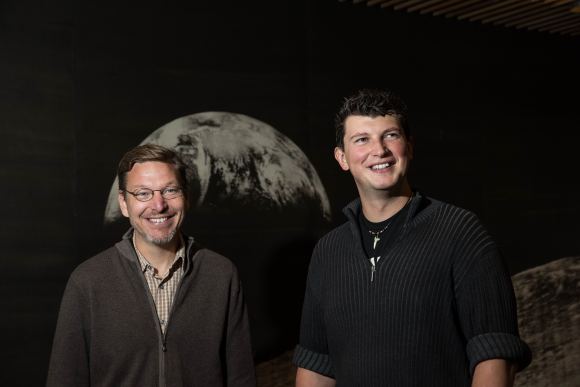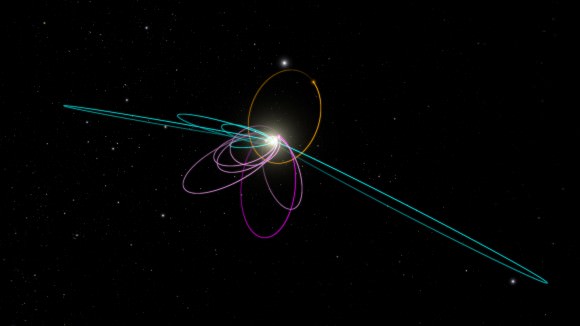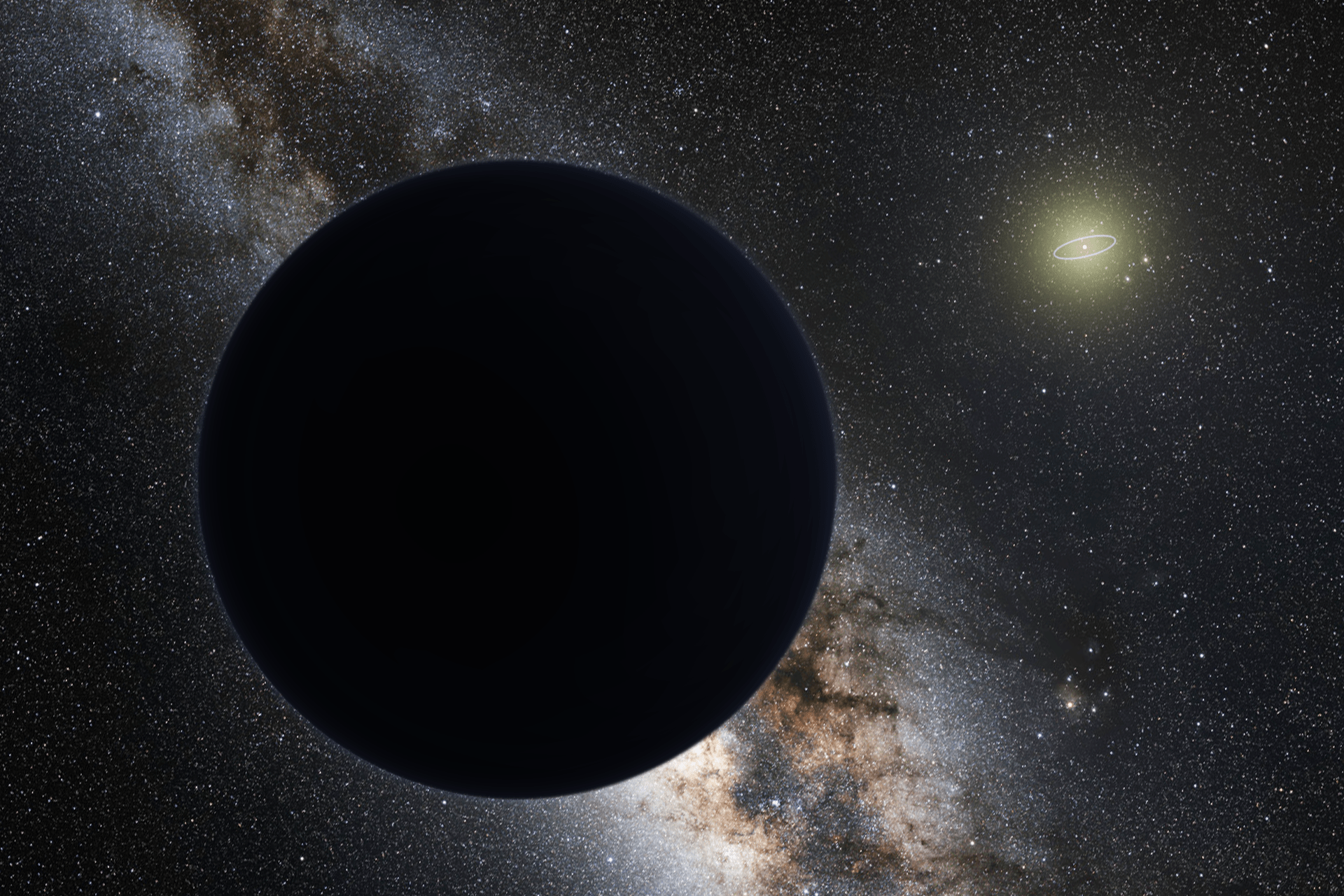Planet 9 cannot hide forever, and new research has narrowed the range of possible locations further! In January of 2016, astronomers Mike Brown and Konstantin Batygin published the first evidence that there might be another planet in our Solar System. Known as “Planet 9” (“Planet X” to some), this hypothetical body was believed to orbit at an extreme distance from our Sun, as evidenced by the orbits of certain extreme Kuiper Belt Objects (eKBOs).
Since that time, multiple studied have been produced that have attempted to place constraints on Planet 9’s location. The latest study once again comes from Brown and Batygin, who conducted an analytical assessment of all the processes that have indicated the presence of Planet 9 so far. Taken together, these indications show that the existence of this body is not only likely, but also essential to the Solar System as we know it.
The study, titled “Dynamical Evolution Induced by Planet Nine“, recently appeared online and has been accepted for publication in The Astronomical Journal. Whereas previous studies have pointed to the behavior of various populations of KBOs as proof of Planet 9, Brown and Batygin sought to provide a coherent theoretical description of the dynamical mechanisms responsible for these effects.
In the end, they concluded that it would be more difficult to imagine a Solar System without a Planet 9 than with one. As Konstantin Batygin explained in a recent NASA press statement:
“There are now five different lines of observational evidence pointing to the existence of Planet Nine. If you were to remove this explanation and imagine Planet Nine does not exist, then you generate more problems than you solve. All of a sudden, you have five different puzzles, and you must come up with five different theories to explain them.”
In 2016, Brown and Batygin described the first three lines of observational evidence for Planet 9. These include six extreme Kuiper Belt Objects which follow highly elliptical paths around the Sun, which are indicative of an unseen mechanism affecting their orbit. Second is the fact that the orbits of these bodies are all tilted the same way – about 30° “downward” to the plane of the Kuiper Belt.
The third hint came in the form of computer simulations that included Planet 9 as part of the Solar System. Based to these simulations, it was apparent that more objects should be tilted with respect to the Solar plane, on the order of about 90 degrees. Thanks to their research, Brown and Batygin found five such objects that happened to fit this orbital pattern, and suspected that more existed.

Since the publication of the original paper, two more indications have emerged for the existence of Planet 9. Another involved the unexplained orbits of more Kuiper Belt Objects which were found to be orbiting in the opposite direction from everything else in the Solar System. This was a telltale indication that a relatively close body with a powerful gravitational force was affecting their orbits.
And then there was the argument presented in a second paper by the team – which was led by Elizabeth Bailey, Batygin’s graduate student. This study argued that Planet 9 was responsible for tilting the orbits of the Solar planets over the past 4.5 billion years. This not only provided additional evidence for Planet 9, but also answered a long standing mystery in astrophysics – why the planets are tilted 6 degrees relative to the Sun’s equator.
As Batygin indicated, all of this adds up to a solid case for the existence of a yet-to-discovered massive planet in the outer Solar System:
“No other model can explain the weirdness of these high-inclination orbits. It turns out that Planet Nine provides a natural avenue for their generation. These things have been twisted out of the solar system plane with help from Planet Nine and then scattered inward by Neptune.”

Recent studies have also shed some light on how and where Planet 9 originated. Whereas some suggested that the planet moved to the edge of the Solar System after forming closer to the Sun, others have suggested that it might be an exoplanet that was captured early in the Solar System’s history. At present, the favored theory appears to be that it formed closer to the Sun and migrated outward over time.
Granted, there is not yet a scientific consensus when it comes to Planet 9 and other astronomers have offered other possible explanations for the evidence cited by Batygin and Brown. For instance, a recent analysis based on the Outer Solar System Origins Survey – which discovered more than 800 new Trans-Neptunian Objects (TNOs) – suggests that the evidence could also be consistent with a random distribution of such objects.
In the meantime, all that remains is to find direct evidence of the planet. At present, Batygin and Brown are attempting to do just that, using the Subaru Telescope at the Mauna Kea Observatory in Hawaii. The detection of this planet will not only settle the matter of whether or not it even exists, it will also help resolve a mystery that emerged in recent years thanks to the discovery of thousands of extra-solar planets.
In short, thanks to the discovery of 3,529 confirmed exoplanets in 2,633 solar systems, astronomers have noticed that statistically, the most likely types of planets are “Super-Earths” and “mini-Neptunes” – i.e. planets that are more massive than Earth but not more than about 10 Earth masses. If Planet 9 is confirmed to exist, which is estimated to have 10 times the Mass of Earth, then it could explain this discrepancy.
Planet 9, we know you’re out there and we will find you! Unless you’re not, in which case, disregard this message!
Further Reads: NASA


Thanks for a well written article on an interesting update!
“For instance, a recent analysis based on the Outer Solar System Origins Survey – which discovered more than 800 new Trans-Neptunian Objects (TNOs) – suggests that the evidence could also be consistent with a random distribution of such objects.”
Brown and Batygin has already responded on the Outer Solar System Origins Survey [OSSOS] in July.They conclude that indeed OSSOS is drawn in a different way than the earlier objects:
“If you look at the OSSOS data in isolation, it contains two objects that are in the purple camp, one green orbit, and the gray outlier. You need to know exactly zero statistics to conclude that these four points DO NOT form a pattern. And this is what the OSSOS team concludes as well, after carrying out a sophisticated account for the observational biases inherent to their survey. Indeed, from the independent OSSOS dataset alone, a random underlying distribution (as opposed to a clustered distribution) cannot be ruled out.
When you look at the full dataset, however, the propensity for orbital clustering is clear. Shankman et al. argue that this clustering is unlikely to be real, and is merely apparent. That is, in their view, observational biases conspire to make certain parts of the night sky more observable than others, leading to the discovery of orbits that share a common orientation more frequent. In striking contrast, a recent paper that Mike put together shows exactly the opposite to be true for the non-OSSOS dataset: observational bias cannot account for orbital clustering beyond 250AU.
Perhaps the resolution lies in that observational surveys that discovered non-OSSOS objects share very little in their design with OSSOS, leading to staggeringly different biases between the OSSOS and non-OSSOS datasets.”
[ http://www.findplanetnine.com/2017/06/status-update-part-1.html ]
Moreover, they conclude that the data is consistent with planet Nine:
“The data point I got considerably more intrigued by is the outlier, 2015 GT50. As already mentioned previously, this object does not belong to either the aligned or anti-aligned cluster, so naively speaking it simply doesn’t fit the model. A more cursory inspection of the above plot however, brings to light the existence of a string of specific orbital radii that correspond to resonances with Planet Nine, where the simulated objects circulate through the full 0-360 degree range of orbital orientations. Remarkably, the outlier (2015 GT50) falls *exactly* on one such orbit (i.e. note on the plot above that the gray point falls on a vertical blue line).
This is kind of staggering. Without changing the Planet Nine parameters at all (to make this plot I’ve adopted the same a=700AU e=0.6 m=10Mearth P9 configuration as in the original Batygin & Brown 2016 AJ paper), the model manages to fit all the data, including the supposed outlier. Of course, the fact that the observed object fits so well with theory might be a coincidence, but this correspondence nevertheless emphasizes that the mere existence of a small number of apsidally unconfined objects that do follow the overall pattern exhibited by the data, does not constitute strong evidence against the Planet Nine hypothesis. Instead, mapping out this comparatively uncommon population of unconfined objects might lend important constraints on P9’s semi-major axis.”
“n addition to the observed objects that were already known back in October of last year, this plot shows two new data points that also fit the simulated pattern beautifully. Thus, the predictions of the Planet Nine hypothesis have held up very well within the more proximate part of the trans-Neptunian region, where the planet’s direct influence is minimal.
So where does the new data leave us? Let’s summarize: while the membership of the primary perihelion cluster has gone from six to ten, the distant belt now also has some objects that do not belong to the apsidally anti-aligned population of long-period KBOs. Despite worries of Planet Nine’s immediate demise, it is pretty clear that these bodies fit well with other dynamical classes predicted by the model, so there’s no real conflict there. Closer to Neptune, we’ve picked up a couple high-inclination objects that also agree well with the model.”
[ http://www.findplanetnine.com/2017/06/status-update-part-1.html , http://www.findplanetnine.com/2017/07/status-update-part-2.html ]
Interesting additional info. Thanks Torbjorn..
I suggest we name it “Pluto”. So we can have things back the way they are supposed to be. Then we could rename the dwarf planet “Styx”. Charon could be “Journey” or something.